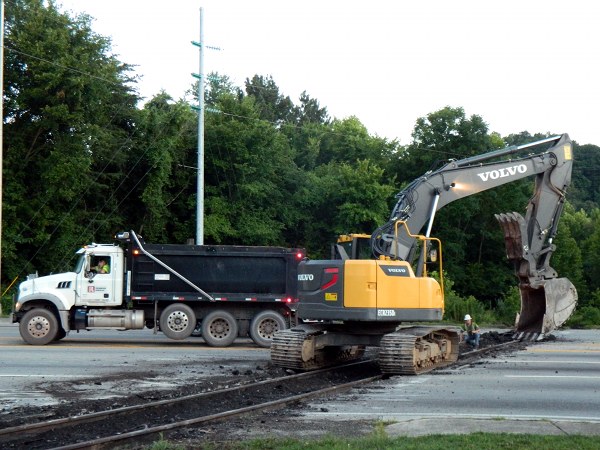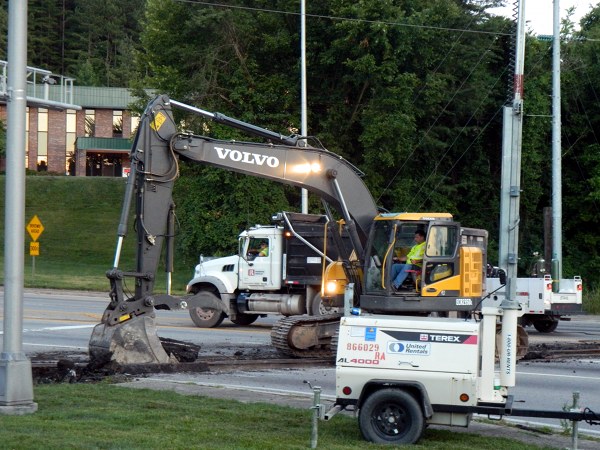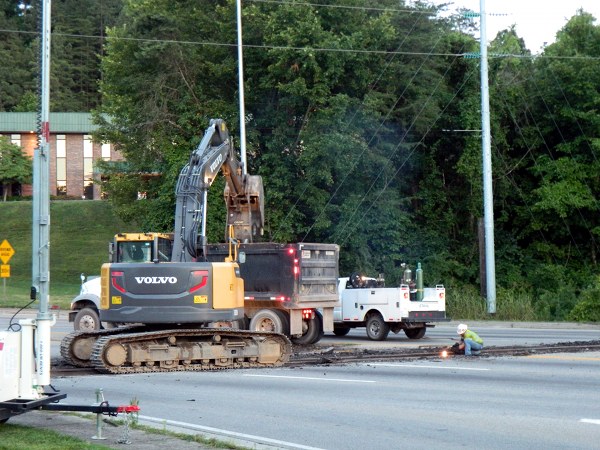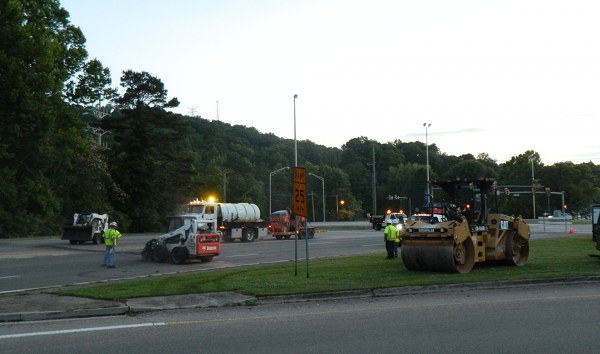
A work crew from Rogers Group removes unused railroad tracks from South Illinois Avenue just south of Lafayette Drive and Scarboro Road on Saturday night. After the tracks were removed, the railroad crossing was repaved, and the road reopened on Sunday.
Note: This story was last updated at 6:30 p.m.
Unused railroad tracks that crossed Briarcliff Avenue, Emory Valley Road, and South Illinois Avenue were removed on Thursday and Saturday night.
Railroad company CSX split the traffic control costs with the city and paid to remove the tracks, Oak Ridge Public Works Director Gary Cinder said. In exchange, the city agreed to repave the roadways as part of street maintenance. The crossing lights were removed as well so that commercial vehicles, including school buses, no longer have to stop at the abandoned crossings and, in the case of school buses and other vehicles that carry children, open and close their doors before proceeding.
The project has been in the works for two years.
“We’re thrilled to finally get to this stage,” Cinder said last week. “It’s been a long time coming.”

The crews used dump trucks, an excavator, and a cutting torch, among other equipment, to remove the tracks.
He said the final cost was not clear yet, but it wasn’t expected to be significant. The city worked with contractor Rogers Group Inc. on the project.
Cinder said there is a separate proposal to remove the tracks in front of the Y-12 National Security Complex, but the city will have to work with the U.S. Department of Energy and National Nuclear Security Administration to remove those tracks. Y-12 is an NNSA site.
In the next year, the city could work on smaller railroad crossings that don’t have signals, Cinder said. The city might be able to remove those tracks and patch the roads.
It’s more evidence that the tracks are not coming back, said Kathryn Baldwin, Oak Ridge Community Development director. That gives the city more credence to ask for the railway property to be turned into a multi-modal pathway that could eventually be used by runners, bicyclists, and pedestrians for shopping, recreation, and commuting to school and work. The abandoned railway runs from Y-12 to the city’s waterfront at Melton Lake Drive. An initiative known as “rails to trails” was included in a bike and pedestrian plan approved in March 2011, but it wasn’t emphasized in that document because, at the time the report was drafted, the railroad was still connected to an active CSX line. But in the last few days of the study, CSX removed tracks that crossed Melton Lake Drive, Baldwin said.
Now, the line is not used, and it appears that it never will be, she said.
Baldwin said there were two actions by DOE and the federal highway transportation board that allowed the tracks to be removed from active roadways. First, DOE, which had the first right of refusal on the tracks, formally notified CSX that the department would not exercise that option on the section of railway from Melton Lake to the Y-12 entrance, meaning the department is not interested in the railway or the land, Baldwin said.
Second, the federal highway transportation board had to approve the project before CSX could make the line inoperable, Baldwin said. That approval has been obtained.
CSX still owns the right-of-way and any improvements in it. Baldwin said the city hasn’t requested the right-of-way, but preliminary discussions have started.
“We think this can serve as an alternative means of transportation,” she said. A trail where the railway is now would allows residents in neighborhoods like Emory Heights to ride a bike to Y-12 to work, and it would permit children in developments such as Hendrix Creek to walk or bike to Jefferson Middle School, for example.
Baldwin said she has requested the preparation of a master plan through the Knoxville Regional Transportation Planning Organization that could help determine access points, rest areas, and bike racks, and help determine where the right-of-way needs to be graded and how the project could be phased.
Baldwin said the right-of-way, if dedicated to the city, could be used even as a walking trail.
“It could be used even without massive improvements,” she said.



Leave a Reply